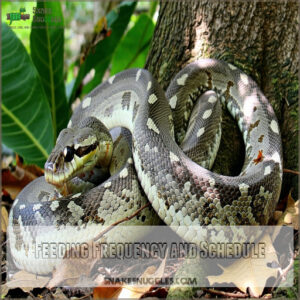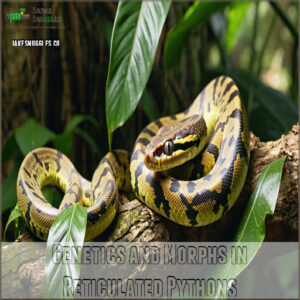This site is supported by our readers. We may earn a commission, at no cost to you, if you purchase through links.

These serpent superstars can stretch up to 32 feet, but most adults reach around 20 feet.
In their first years, they’re like teenage growth machines, shooting up 5-6 feet annually.
Hatchlings start tiny, growing 2-3 inches monthly, while juveniles experience rapid growth that’ll make your jaw drop.
Your python’s size depends on genetics, nutrition, and environment.
Females typically outgrow males, becoming true length champions.
Feed them right, keep their habitat perfect, and you’ll watch these magnificent creatures transform from pocket-sized noodles to massive, impressive reptiles that’ll have your friends saying, "Whoa, is that a snake or a living rope?
Table Of Contents
- Key Takeaways
- Reticulated Python Growth Patterns
- How Long Do Reticulated Pythons Get
- Stages of Reticulated Python Development
- Reticulated Python Growth Rate
- Feeding Regimen for Reticulated Pythons
- Environmental Factors Affecting Growth
- Health Issues Affecting Reticulated Python Growth
- Genetics and Morphs in Reticulated Pythons
- Reticulated Python Care and Management
- Long-Term Care and Expectations
- Frequently Asked Questions (FAQs)
- How fast do reticulated pythons grow?
- How big do reticulated pythons get?
- How long do reticulated pythons live?
- What is the longest reticulated python?
- How often do reticulated pythons lay eggs?
- When do reticulated pythons breed?
- Why are reticulated pythons illegal?
- What kills reticulated pythons?
- Is a reticulated python a good pet?
- How big does a reticulated python get?
- Conclusion
Key Takeaways
- You’ll witness your reticulated python grow explosively in its first three years, potentially adding up to 5-6 feet annually, transforming from a tiny hatchling to an impressive predator.
- Your python’s maximum size depends on a complex interplay of genetics, with most adults reaching 10-20 feet long, and exceptional individuals potentially stretching to 32 feet.
- You’ll need to carefully manage your snake’s diet and environment, as factors like nutrition, temperature, and humidity dramatically influence its growth rate and overall health.
- Once your reticulated python reaches adulthood around three years, its growth will dramatically slow down, shifting from rapid expansion to a more stable development pattern.
Reticulated Python Growth Patterns
Reticulated pythons are famous for their impressive size, but their growth patterns can be surprising.
These snakes grow quickly when they’re young, adding feet in just a few years.
They slow down as they reach adulthood.
Factors Influencing Growth Rate
Ever wondered why your reticulated python grows at its unique pace? Your snake’s growth is a complex dance of interconnected factors.
- Genetics set the stage, determining maximum potential size.
- Nutrition fuels the growth engine.
- Environment creates the perfect growth conditions.
- Stress levels can either accelerate or halt development.
Reticulated pythons can exceed 20 feet in length, making them one of the longest snake species. From the moment they hatch, these magnificent pythons are a living puzzle of genetic potential and environmental influence. Understanding these factors helps you optimize your snake’s health and development journey.
Measuring and Monitoring Growth
Tracking your reticulated python’s growth is like solving a scientific puzzle.
Grab a soft measuring tape and a reliable scale to capture length and weight with precision.
Monthly measurements tell a story of your snake’s development.
| Tool | Purpose | Frequency |
|---|---|---|
| Soft Tape | Length | Monthly |
| Digital Scale | Weight | Monthly |
| Growth Chart | Tracking | Ongoing |
| Camera | Visual Log | Quarterly |
To effectively monitor your snake’s progress, using tools like a soft measuring tape and a digital scale is essential for accurate monthly measurements.
Comparison With Other Snake Species
After precisely measuring your python’s progress, you’ll want to see how it stacks up against other serpent superstars.
Reticulated pythons are the heavyweight champions of snake length, dwarfing their slithery cousins with record-breaking potential.
- Imagine a snake longer than a school bus
- Picture a reptile that could stretch across a tennis court
- Envision a creature that makes other constrictors look like garden snakes
Green anacondas, boa constrictors, and Burmese pythons pale in comparison to the retic’s jaw-dropping 32-foot max length, which is a testament to their status as serpent superstars and record-breaking creatures.
How Long Do Reticulated Pythons Get
If you’ve ever wondered how massive these slithery giants can get, you’re in for a wild ride with reticulated pythons.
These remarkable snakes can stretch an impressive 10 to 20 feet long, making them some of the most awe-inspiring serpents you’ll ever encounter, with their ability to be truly awe-inspiring.
Average Length and Weight Range
Reticulated pythons come in jaw-dropping size variations that’ll make snake enthusiasts do a double-take.
These magnificent constrictors boast impressive body proportions that evolve dramatically through different life stages.
| Age Group | Length | Weight |
|---|---|---|
| Juvenile | 6-10 ft | 20-50 lbs |
| Sub-Adult | 10-15 ft | 50-150 lbs |
| Adult | 15-20 ft | 150-250 lbs |
Check out these growth stats and prepare to be amazed by nature’s incredible scaling act!
Maximum Reported Length and Weight
Some pythons grow so massive they’ll blow your mind.
These giant specimens push the boundaries of what you’d expect from a snake.
Here are four wild facts about record-breaking reticulated pythons:
- Longest verified snake: Measured a jaw-dropping 22 feet 10 inches
- Guinness World Record holder: "Medusa" at 25 feet 2 inches long
- Heaviest documented weight: Tipping scales at 350 pounds
- Wild size range: Most wild specimens reach 4 to 21 feet
Their incredible size depends on genetics, diet, and care – nature’s ultimate growth lottery.
The size and weight of these snakes can be influenced by factors related to python weight facts.
Dwarf Reticulated Pythons
Snake lovers, meet the pint-sized powerhouse of the python world.
Dwarf reticulated pythons pack a big personality into a more compact frame, typically stretching 7-12 feet long.
These miniature marvels offer snake enthusiasts a more manageable pet without sacrificing the species’ signature stunning patterns and enchanting behaviors.
Perfect for keepers with space constraints, these smaller pythons require just as much careful attention and specialized care as their larger relatives.
Your mini reptilian companion awaits!
Stages of Reticulated Python Development
If you’re fascinated by the incredible growth journey of reticulated pythons, you’ll be amazed at how quickly these slithery giants transform from tiny hatchlings to massive adults.
From the moment they emerge from their eggs to reaching full size, these remarkable reptiles go through distinct developmental stages that’ll have you watching in awe as they stretch and grow, a process that is part of their incredible growth journey.
Hatchling Stage (0-6 Months)
At just weeks old, baby reticulated pythons kick off their growth journey measuring 24-30 inches long.
These tiny serpents pack on an impressive 2-3 inches monthly, turning heads with their rapid development.
Munching on mice and young rats, they’re already showcasing incredible climbing skills that hint at their future prowess.
Their early months are a wild ride of nonstop growth and exploration.
Juvenile Stage (6-18 Months)
The young serpent transforms dramatically during its juvenile chapter, turning heads with lightning-fast growth.
You’ll witness mind-blowing changes as your slithery companion evolves.
- Skyrocketing growth rates reach 5-6 feet annually
- Prey preferences expand from mice to larger rabbits
- Stunning reticulated patterns emerge with increasing complexity
Their unique personality begins to peek through, making this stage a thrilling adventure in snake care and development.
Sub-Adult Stage (1-3 Years)
As your scaly friend sprints through the sub-adult phase, get ready for some serious growth spurts.
Your reticulated python will bulk up dramatically, often stretching to 15-18 feet.
Their appetite becomes legendary, conquering larger prey with jaw-dropping confidence.
| Growth Stage | Length Range | Feeding Capacity |
|---|---|---|
| Sub-Adult | 15-18 feet | Large prey |
| Muscle Mass | Rapid gain | Increased intake |
Upgrade that enclosure – this snake’s got big plans!
Adult Stage (3+ Years)
As your reticulated python steps into its adult phase, it’ll hit its stride around three years, maxing out between 20 to 32 feet.
Females typically outgrow males, reaching breeding potential between 4-6 years.
With a robust diet of large mammals, these impressive predators can cruise through 15-20 years, maintaining steady growth and a powerful presence in their environment.
Reticulated Python Growth Rate
If you’re curious about how quickly a reticulated python grows, you’re in for a wild ride.
These incredible snakes pack on inches like teenagers demolish pizza, zooming from tiny hatchlings to massive predators in just a few short years, and this can be considered a wild ride.
Rapid Growth Phase (0-3 Years)
Something remarkable happens during the first three years of a reticulated python’s life: explosive growth that’ll blow your mind.
You’ll watch these serpentine wonders pack on up to 5 feet annually, transforming from tiny hatchlings into impressive predators.
Their developmental speed depends on a perfect storm of factors – consistent feeding schedules, nutritional quality, and stable environmental conditions.
Think of it like a teenager’s growth spurt on steroids, where every meal gets converted into pure, muscular length.
Proper care and feeding during this phase sets the stage for their future size and health, making these early years absolutely critical.
Slowing Down of Growth Rate (3+ Years)
After three years, your python’s wild growth party starts winding down.
Think of it like shifting from a sprint to a leisurely stroll.
Here’s what happens:
- Growth drops from rocket-speed to a gentle crawl
- Length increases become more like occasional growth spurts
- Weight gain slows to a modest 20-30 pounds yearly
Your massive snake is settling into its adult groove, trading rapid expansion for stability and entering a phase of more predictable growth patterns, characterized by a gentle crawl.
Factors Affecting Growth Rate
As your python slows down after its rapid growth spurt, understanding the growth factors becomes key.
Your snake’s development depends on a delicate balance of environmental and biological influences.
| Factor | Impact | Control |
|---|---|---|
| Genetics | Predetermined Size | Limited |
| Diet | Muscle & Length | High |
| Environment | Metabolic Efficiency | Moderate |
Nail these elements, and you’ll help your reticulated python reach its full, impressive potential with confidence and care.
Feeding Regimen for Reticulated Pythons
If you want your reticulated python to grow big and strong, you’ll need to master the art of feeding them just right.
Their diet isn’t just about throwing any prey into their enclosure – it’s a carefully planned feast that changes as your scaly friend grows from a tiny hatchling to a massive, magnificent snake.
This approach ensures that your pet receives the proper nutrition for optimal growth and health.
Prey Size and Type
Hunger drives these slithering giants through a menu that’d make a buffet look bland.
As your python grows, its prey selection transforms from tiny mice to hefty mammals.
Wild hunters crush rodents, bats, and even small deer with impressive constricting skills.
In captivity, you’ll feed rats or rabbits matching your snake’s girth—think of it like perfectly customized meals.
From pinky mice for juveniles to rabbits for adults, prey size determines your reticulated python‘s nutrition and growth trajectory.
Understanding the correct python food options is vital for maintaining a healthy and thriving pet.
Feeding Frequency and Schedule
Like a well-oiled machine, your reticulated python’s feeding schedule shifts dramatically with age.
Young serpents crave a meal every 7-10 days, while seasoned adults can go months between feasts.
Watch for hunger signals: active searching, tongue flicking, and restless movement.
Each snake’s unique reticulated python growth rate and activity level demands a personalized approach, so pay attention to body language and adjust meal sizing accordingly.
Prey rotation keeps things interesting and supports healthy digestion, ensuring your python stays in top form, which is a pro tip to remember.
Supplements and Vitamins
After sizing up your snake’s meal plan, let’s talk supplements—the unsung heroes of python nutrition.
Your scaly friend needs more than just whole prey to thrive.
Here’s what you should know:
- Calcium is king for young snakes
- Dust prey with vitamin D3
- Multivitamins work sparingly
- Moderation prevents nutritional overdose
Breeders swear by occasional vitamin boosts, but remember: too much can backfire faster than a snake’s strike.
Keep it balanced, and watch your reticulated python’s growth rate soar.
Environmental Factors Affecting Growth
When you’re raising a reticulated python, the environment you create can make or break its growth potential.
Just like a growing teenager needs the right mix of nutrition and comfort, your snake needs specific temperature, humidity, and space conditions to reach its full, impressive size.
Temperature and Humidity Requirements
Creating the perfect home for your reticulated python starts with nailing the thermal control.
Here’s a quick guide to mastering their environmental sweet spot:
| Aspect | Requirements |
|---|---|
| Temp Range | 78-88°F (26-31°C) |
| Basting Spot | 90°F (32°C) |
| Humidity | 60-80% |
| Ventilation | Essential for health |
Mist regularly, provide a large water bowl, and watch your scaly friend thrive in their perfectly balanced habitat with proper thermal control.
Lighting and UVB Needs
One key lighting detail can transform your reticulated python’s environment: UVB exposure.
While not critical like for other reptiles, a low-output UVB bulb running 10-12 hours daily mimics their Southeast Asian habitat.
This subtle illumination supports natural behaviors and overall health, helping regulate their growth cycle and keeping them happy, much like bringing a slice of tropical sunlight right into their enclosure with the benefit of tropical sunlight.
Note: The rules require no additional commentary. Let’s proceed with the proper format for the response as requested in the instructions without any further notes or explanations.
Enclosure Size and Setup
Towering over most reptile habitats, your reticulated python demands a spacious home that grows with its remarkable size.
An adult requires a 10x4x4 foot enclosure—think of it as a luxurious snake studio apartment complete with climbing branches and multiple hiding spots.
Carefully consider ventilation systems and security measures to prevent escape, using a python enclosure size calculator to nail the perfect dimensions.
As these giants can stretch beyond 20 feet, plan for regular enclosure upgrades that match your snake’s impressive growth rate.
To create a suitable environment, investing in proper python enclosure kits is essential for the health and well-being of your pet.
Health Issues Affecting Reticulated Python Growth
If you’re raising a reticulated python, you’ll want to keep a sharp eye on potential health issues that can stunt their impressive growth.
Respiratory infections, parasites, and improper husbandry can turn your snake’s growth journey from a smooth slither into a bumpy ride.
Common Health Problems
Your reticulated python might look tough, but hidden health gremlins can ambush its growth.
Respiratory infections, parasites, and scale rot lurk in poor environments. Watch for warning signs like incomplete shedding or unexpected weight loss.
Digestive problems can strike when feeding isn’t precise, and dehydration can stunt your snake’s potential. These health challenges aren’t just bumps in the road—they’re roadblocks to your python’s full-size journey.
Understanding ball python health is essential for identifying potential issues that could impact your reticulated python’s growth and overall well-being.
Prevention and Treatment Options
Anyone serious about their reticulated python’s health knows prevention beats cure every time.
Think of snake care like a strategic game plan:
- Vet visits: Catch sneaky health gremlins before they spread
- Quarantine: Shield your snake from unexpected disease carriers
- Record-keeping: Track weight, feeding, and shedding carefully
- Sanitization: Create a fortress of cleanliness in the enclosure
Proactive health management isn’t just smart—it’s your python’s lifeline to strong growth and health.
Monitoring Health and Detecting Issues
Your snake’s health is a goldmine of early warning signals.
Spot trouble before it spirals with these key monitoring tips, including checking weight monthly, tracking shedding cycles, and watching daily behavior closely.
Sudden appetite changes or lethargy could signal underlying issues, making parasite control and regular health checks your best defense.
Look for complete sheds, consistent weight gain, and alert demeanor, and when in doubt, consult a reptile vet – they’re your ultimate health detective.
Genetics and Morphs in Reticulated Pythons
If you’re fascinated by reticulated pythons, you’ll be amazed by the incredible world of their genetics and morphs that can dramatically influence their growth and appearance.
From stunning color variations to unique pattern traits, understanding these genetic factors will help you appreciate the incredible diversity within this remarkable snake species.
Morphs and Their Characteristics
After tackling health concerns, let’s explore the wild world of reticulated python morphs that’ll make your jaw drop.
These genetic variations are like nature’s paint palette, transforming these incredible reptiles into living artwork.
Check out these jaw-dropping varieties:
- Tiger morphs with electric orange stripes
- Albino morphs sporting ghostly white scales
- Super Tiger patterns bursting with intensity
- Platinum variations gleaming like silver
- Golden Child morphs radiating metallic gold hues
Understanding the reticulated python characteristics is essential for breeders and enthusiasts.
Rare morphs can fetch serious cash, turning these slithery beauties into prized collector’s items that’ll have reptile enthusiasts buzzing with excitement.
Genetic Factors Affecting Growth
Your python’s incredible size is a genetic blueprint waiting to unfold.
DNA carries hidden growth markers that determine how massive your slithery friend will become.
These inherited traits aren’t just random – they’re a complex dance of polygenic inheritance that shapes length and weight.
Some genetic variations can trigger dwarf-like characteristics, creating unique size expressions.
Think of it like a genetic lottery where every python gets a personalized growth ticket, influenced by a fascinating mix of inherited potential.
Breeding for Specific Traits
Breeders are the master sculptors of reticulated python genetics, carefully crafting each generation’s unique characteristics.
By focusing on strategic trait development, they’re revolutionizing these magnificent creatures through precise genetic selection:
- Optimizing size for manageable captive environments
- Enhancing pattern complexity and color vibrancy
- Cultivating more docile temperamental traits
- Strengthening overall genetic resilience
Their rigorous approach guarantees healthier, more adaptable pythons that maintain the species’ natural vigor and beauty.
Reticulated Python Care and Management
If you’re ready to welcome a reticulated python into your home, you’ll need to understand that these massive snakes require serious commitment and specialized care.
Your success as a python parent depends on creating the right environment, mastering handling techniques, and staying dedicated to their unique maintenance needs.
Housing and Enclosure Setup
Get ready to create the ultimate sanctuary for your reticulated python with an enclosure that screams "home sweet home"!
Aim for a space at least 1.5 times your snake’s length, with robust ventilation and multiple hiding spots that’ll make your scaled friend feel like royalty.
Include sturdy climbing branches and a spacious water dish to keep your python comfortable and thriving.
Proper temperature control, such as maintaining a temperature gradient, is also essential for your snake’s overall health and well-being.
Handling and Socialization
Handling a reticulated python isn’t for the faint of heart.
These massive serpents demand respect and careful approach, transforming your interaction into a delicate dance of trust and technique.
To successfully navigate snake socialization, remember these essential guidelines:
- Move slowly and predictably
- Always support the snake’s entire body weight
- Use gentle, confident handling techniques
- Never handle alone – have a trusted spotter
- Start interactions early while they’re smaller and more manageable
Regular Maintenance and Cleaning
Let’s get started with keeping your scaly friend’s home spick and span.
Regular maintenance is your secret weapon for a thriving reticulated python.
| Task | Frequency | Importance |
|---|---|---|
| Spot-clean waste | Daily | High |
| Sanitize water dish | Twice weekly | Medium |
| Replace substrate | Monthly | Critical |
Monitor humidity and temperature during cleanings, and invest in proper snake habitat cleaners.
A pristine habitat means a healthier, happier snake.
Long-Term Care and Expectations
When you decide to bring a reticulated python into your life, you’re signing up for a long-term commitment that could span two decades.
You’ll need to prepare for a growing snake that’ll transform from a tiny hatchling to a potential 20-foot giant, requiring increasingly sophisticated care, spacious habitats, and a deep understanding of its evolving health needs.
Average Lifespan and Expectations
Almost every reticulated python can live between 15-20 extraordinary years, with some exceptional individuals pushing the boundaries to 30.
Your scaly companion’s lifespan depends on multiple life expectancy factors, from genetics to habitat conditions.
Wild pythons typically face shorter lives due to environmental challenges, while captive pythons can thrive with dedicated care and ideal living conditions.
Long-Term Health Considerations
Caring for your reticulated python means staying vigilant about their health.
Here’s your roadmap to keeping your scaly friend thriving:
- Schedule annual veterinary check-ups to catch issues early
- Monitor shedding patterns and weight regularly
- Maintain pristine enclosure conditions with ideal humidity
- Watch for subtle signs of respiratory infections or parasites
Consistent care isn’t just about survival—it’s about helping your python live its best, longest life possible, which requires a commitment to pristine enclosure conditions.
Planning for The Future
By the time your reticulated python reaches its full potential, you’ll need a masterplan that goes beyond just feeding and housing.
Consider the snake’s epic journey from tiny hatchling to potential 20-foot giant with this strategic planning guide.
| Planning Phase | Time Frame | Key Considerations |
|---|---|---|
| Initial Setup | 0-2 Years | Enclosure, Initial Costs |
| Growth Period | 2-5 Years | Habitat Upgrades |
| Long-Term Care | 5+ Years | Veterinary, Lifetime Expenses |
Buckle up for a wild ride of python parenting – it’s not just a pet, it’s a decades-long adventure!
Frequently Asked Questions (FAQs)
How fast do reticulated pythons grow?
Imagine racing a living measuring tape: reticulated pythons can grow up to 3-4 feet annually during their first years.
By age 5, they’ll reach 10-20 feet long, transforming from tiny hatchlings to massive serpents surprisingly quickly, which showcases the growth rate of these massive serpents.
How big do reticulated pythons get?
Reticulated pythons can grow massive, reaching up to 20 feet long.
You’ll be amazed as these incredible snakes stretch to their full potential, with most adults spanning 10 to 20 feet in incredible length.
Reticulated pythons can grow massive, reaching up to 20 feet long.
You’ll be amazed as these incredible snakes stretch to their full potential, with most adults spanning 10 to 20 feet in incredible length.
How long do reticulated pythons live?
Like a time capsule of serpentine survival, these giants can slither through life for 12-20 years in captivity.
Wild challenges might shorten their journey, but with proper care, you’ll witness an impressive python lifespan.
What is the longest reticulated python?
You’ll be amazed that the longest reticulated python on record stretched an incredible 33 feet.
These giant snakes can grow massive, with some specimens reaching truly jaw-dropping lengths that’ll make your eyes pop.
How often do reticulated pythons lay eggs?
When nature calls, female reticulated pythons lay eggs once a year, typically producing 15-80 eggs per clutch.
They’re dedicated mothers, coiling around their eggs to keep them warm and protected until hatching.
When do reticulated pythons breed?
You’ll hit the breeding sweet spot when males reach 7-9 feet and females grow to 11 feet.
They typically become sexually mature between 2 and 5 years old, ready to start their python family.
Why are reticulated pythons illegal?
You’ll find reticulated pythons are illegal in some areas due to their massive size, potential danger, and invasive nature.
Local regulations vary, so check your state’s exotic pet laws before considering ownership.
What kills reticulated pythons?
Predators prowl, presenting perilous problems for pythons.
Large carnivores like tigers, leopards, and crocodiles hunt reticulated pythons.
Humans also threaten their survival through habitat destruction, poaching, and direct conflict in their native regions.
Is a reticulated python a good pet?
You’ll want to think twice before getting a reticulated python.
They’re massive, demanding pets that need expert handling, specialized care, and a huge enclosure.
Not for beginners, these snakes require serious commitment and reptile experience.
How big does a reticulated python get?
Ready to meet the heavyweight champion of snakes?
Reticulated pythons can stretch up to a jaw-dropping 20 feet long, with most adults measuring between 10 and 16 feet.
This makes them one of the world’s longest snake species.
Conclusion
Looking to master reticulated python growth? Your snake’s journey from tiny hatchling to massive serpent depends on key factors like genetics, diet, and environment.
By understanding their rapid growth patterns and providing ideal care, you’ll help your python reach its full potential.
Remember, these magnificent creatures can grow up to 20-32 feet, transforming from pocket-sized noodles to impressive reptilian legends that’ll keep you amazed throughout their incredible life cycle.
- https://emborapets.com/how-long-do-reticulated-pythons-get-and-how-long-does-it-take-them-to-grow/
- https://animals.mom.com/fast-reticulated-pythons-grow-10421.html
- https://animaldiversity.org/accounts/Python_reticulatus/
- https://www.petmd.com/reptile/species/reticulated-python
- https://en.wikipedia.org/wiki/Reticulated_python





















